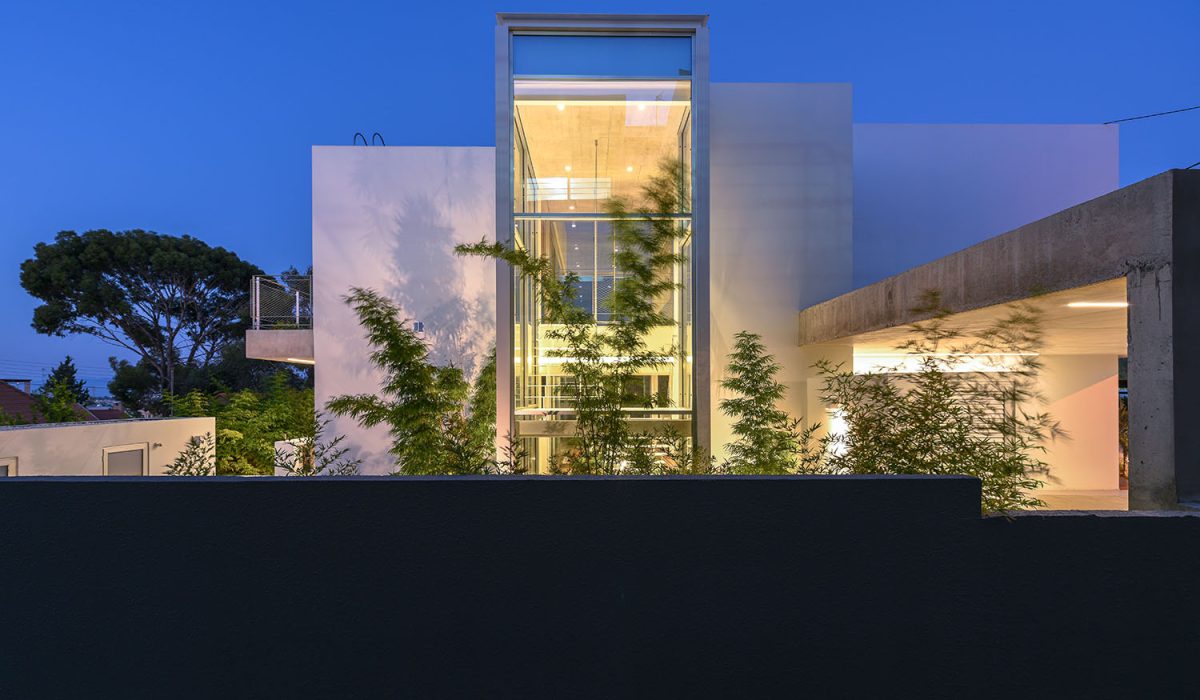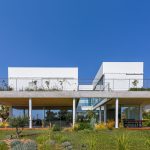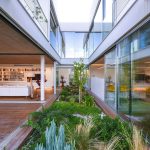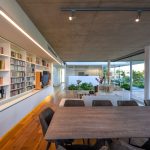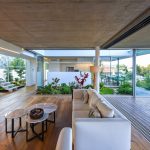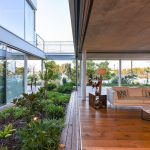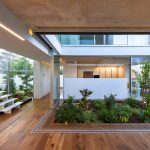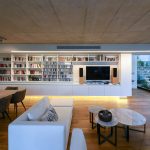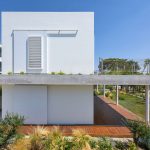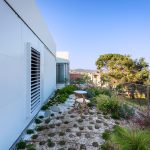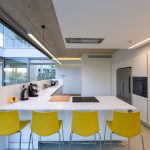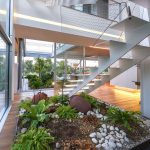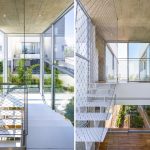Κρατικά Βραβεία Αρχιτεκτονικής 2019
Κατηγορία Α – Αξιόλογο Αρχιτεκτονικό Έργο
Αρχιτέκτονας, Χρίστος Παύλου
Βελτιώνοντας την ποιότητα ζωής στην πολη δημιουργώντας οικοσυστήματα
Η πόλη θεωρείται μια από τις σημαντικότερες αιτίες περιβαλλοντικών προβλημάτων. Αντιμετωπίζοντας το κάθε κτίριο της πόλης ως οικοσύστημα θα μπορούσαμε να βελτιώσουμε τις συνθήκες διαβίωσης των κατοίκων των πόλεων και κατά συνέπεια την ποιότητα ζωής στην κάθε γειτονιά. Σε αντίθεση με πολλές οικίες εντος πόλεων που κρύβονται πίσω από ψηλούς μαντρότοιχους και πράσινους φράκτες εμείς θέλαμε το σπίτι κήπος να αποτελεί την φυσική συνεχεία του δημόσιου χώρου πρασίνου στον οποίο εφάπτεται, ενώ παράλληλα να αποτελεί μέρος του ενιαίου αστικού συνόλου. Η σύνδεση αυτή μεταξύ οικίας, δημόσιου χώρου και γειτονιάς δίνει την αίσθηση ότι, τα τρία αυτά στοιχειά αποτελούν μια συμπαγή ενότητα σε διαρκή αλληλοεπίδραση, η οποία προσδιορίζεται από τον διπλό ρόλο του μέσα και του έξω. Με αυτό τον τρόπο η οικία συμβάλει στην βελτίωση της ποιότητας του αστικού χώρου, στη μείωση της ατμοσφαιρικής ρύπανσης και παράλληλα αποτελεί εστία βιοποικιλότητας για την πολη.
Διατήρηση της βιοποικιλότητας
Βασικό κομμάτι του σχεδιασμού αποτέλεσε η ανάπτυξη κήπων, τόσο στο ισόγειο, όσο και στον όροφο, όπου αντί συμβατικών βεραντών τοποθετήθηκε φυτεμένο δώμα, το οποίο είναι προσβασιμο. Η οικία ανεγέρθηκε στο σχεδόν μισό οικόπεδο ενώ το υπόλοιπο διατηρήθηκε ως κήπος, που ποτίζεται με σύστημα άρδευσης που τροφοδοτείται από γεώτρηση, ώστε να ελαχιστοποιούνται οι επιπτώσεις στους περιορισμένους υδάτινους πόρους του τόπου. Ζητούμενο από την αρχή ήταν η φύτευση με ξηρανθεκτικα είδη, κατάλληλα στις νέες διαμορφωμένες κλιματικές απαιτήσεις της Λευκωσίας, που να συνάδουν με το κυπριακό τοπίο, ώστε να ενθαρρύνεται η ανάπτυξη ενός φυσικού περιβάλλοντος φιλικού προς τα είδη που παρατηρούνται στις πόλεις, όπως τα πουλιά και οι μέλισσες που συμβάλλουν σημαντικά στη διατήρηση της βιοποικιλότητας και της γεωργικής παράγωγης. Το μεγαλύτερο μέρος του κήπου στο ισόγειο έχει φυτευτεί με μελισσοχορτο, το οποίο πέραν της ανθεκτικότητας του στις υψηλές θερμοκρασίες και τις χαμηλές απαίτησης του σε νερό και συντήρηση, αποτελεί ιδανικό μέρος αναζήτησης τροφής για τις μέλισσες, χάρη στην μεγάλη περιεκτικότητα του σε νέκταρ. Από τα 100 είδη καλλιεργειών, το οποίο παράγουν το 90% της παγκόσμιας τροφής, 71 είδη επικονοιαζονται από τις μέλισσες.
Σχεδιασμός
Η οικία σχεδιάστηκε ώστε, σε πρώτη φάση να καλύψει τις ελάχιστες σημερινές ανάγκες του χρήστη. Αναπτύσσεται σε δυο ορόφους μέσα σε δυο μονολιθικούς όγκους με πράσινο αίθριο ενδιάμεσα. Στο ισόγειο βρίσκονται οι χώροι του καθιστικού και της τραπεζαρίας, ξεχωριστή κουζίνα, ένα μικρό wc, διπλός παράλληλος στεγασμένος χώρος στάθμευσης, ενώ στο όροφο βρίσκονται δυο υπνοδωμάτια. Έγινε επίσης, πρόνοια χώρου για προσθήκη ακόμα δυο υπνοδωματίων για να καλύψουν τυχόν μελλοντικές ανάγκες του χρήστη, χωρίς βέβαια να αλλοιώνονται οι βασικές όψεις η ο κήπος της οικίας.
Πρόθεση μας ήταν η μεγιστοποίηση των ανοιγμάτων προς τον δημόσιο χώρο πρασίνου, ο οποίος εφάπτεται νότιο-ανατολικά του συνόρου άλλα ταυτόχρονα ελαχιστοποιώντας την άμεση έκθεση στον ηλιο χρησιμοποιώντας παθητικές λύσεις ηλιακού σχεδιασμού. Στον όροφο οι όψεις διαμορφώνονται με συρόμενα πανελλα αλουμινίου με ενσωματωμένο πετροβαμβακα παρέχοντας ηχομόνωση, ελεγχόμενο φως και προστασία από την άμεση ακτινοβολία του ηλίου κατά τους θερινούς μήνες. Το φυτεμένο δώμα λειτουργεί ως βαθύς πρόβολος, προστατεύοντας τις βεράντες και τους χώρους του ισόγειου, συμβάλλοντας στην μείωση του ενεργειακού φορτίου της οικίας. Ο βιοκλιματικός σχεδιασμός της οικίας βασίζεται στην χρήση φωτοβολταικων πλαισίων/ ηλιακών συλλεκτών που εντάσσονται στην οικία χωρίς να είναι εμφανής, στο φαινόμενο της καμινάδας με την βοήθεια του πράσινου αίθριου εντος της οικίας και στον φυσικό δροσισμό που δημιουργείται από ρεύματα αέρος στον άξονα νότου – βορράς.
Ένα μικρό λιθαράκι
Θεωρούμαι ότι το σπίτι κήπος βάζει ένα μικρό άλλα σημαντικό λιθαράκι στην διατήρηση της βιοποικιλότητας και στην βελτίωση της ποιότητας του αστικού χώρου χωρίς να προκαλεί, ούτε να “φωνάζει” αρχιτεκτονικά, άλλα με τις λιτές γραμμές και τους απλούς όγκους που το χαρακτηρίζουν ενσωματώνεται αρμονικά στον ιστό της γειτονιάς χωρίς να επισκιάζει τον χώρο.
THE GARDEN HOUSE IN THE CITY
State Architecture Awards 2019
Category A – Outstanding Architectural Work
Christos Pavlou architecture
Cities are considered to be one of the major reasons for the many environmental issues we have today. Studies show that cities emit 60% more carbon that thought, in fact they account for more than 70% of the global CO2 emissions. With our garden house project we would like to emphasise how much potential there is for urban gardens and for the creation of microclimates which could improve the living conditions within cities and slow global warming. The integration of a singular house into the urban fabric is always a challenge but it can function in a positive way as a unifying element that may promotes urban continuity in a positive way. In contrast with other many urban houses built to isolate themselves from the rest of the neighbourhood erecting fences and various barriers our proposal aimed to form a physical continuation of the public green area that exists on the longest side of the plot. Our design seeks to establish a unified relationship between the neighbourhood, the private garden and the public green area. In this way urban elements such as building, street and public space are not treated as absolute activities in isolation but as one single homogeneous configuration. Our house becomes part of the park and the park is included in the house, in a sense the two are interrelated with shared places such as the pedestrian pathway, the garden, the veranda , the door threshold ect. and are considered as elements of one big house-like city. In this way our garden house helps to upgrade the quality of the urban fabric and at the same time seeks out to improve the biodiversity and thus reduce the carbon dioxide footprints in the city.
Central element of the house was planting of gardens on 60% of the plot on ground floor and promoting the use of green terrace on first floor. Bee lawn was mostly planted on ground floor creating a friendly environment for bees helping thus to maintain the biodiversity. Studies show that 75% of the world’s food crops rely on bees. The building is designed in two rectangular cubes with a green courtyard in-between them. The idea of the inner garden makes it hard to realize where the garden stops and the interior begins. The garden at the centre is the main feature in the house around which the rest of the spaces organised and function. The green seems to bisect the house from east to west; it flows deep into the interior, fills the unusable space under the staircase and escapes out to the other side of the house. All areas inside tend to concentrate on the outer spaces, the whole house becomes an in-between zone, a rich, tense interior but enjoyable at the same time improving thus the pleasure and comfort of the occupants.
The ground floor is an area that makes the architecture and the landscape meet through open spaces. The open ground floor enables you to connect with the surroundings and the house tends to concentrate on the outer spaces, the long covered deck , the garden, the public park and the distant visibility of the city and surrounding parks. Ground floor consists of a living/dining area, a separate kitchen and a small wc but on the first floor there are two bedrooms. The layout of the bedrooms are very much decided by the wish of the client that all rooms should have direct access to the green terrace and enjoy views of the city and Pentadaktilos mountain. The master bedroom is separated from the rest of the house by means of the double height volume of the atrium. As one moves from one room to another follows the longitudinal axis which runs parallel to the panorama of the city , the gardens and the nearby parks. Provisions were made so that two more bedrooms, one on ground floor and another one on upper floor, may build in the future when need arises but without disturbing the main facades or gardens. Baboon planting was used to form a visual barrier between the fully glazed staircase and the three story block of flats that overlooks the house on the west side.
A long slim 24m glazed sliding door system fully opens up to the south-east orientation to capture the views of the garden, the park and the city but also enhance uninterrupted connections between indoor and the outdoor surroundings. We wanted to create a relaxed in-between space in which interior and exterior intermingle and use architecture as means to connect people to nature in the city. These glazed doors not only separate the spaces inside but when are open the whole house behaves as a single space connected by gardens. The façade has operable sliding panels with louvers made of aluminium. These offer protection from the unbearable Mediterranean direct sunlight but also provide privacy from the close proximity neighbourhood; in the winter panels may slide back so that the winter sun warms the bedrooms. On ground floor the long projected first floor slab protects ground floor interior from the direct south-east sun but also is used as a green terrace for the upper floor which helps to reduce heat load gains during summer. This outdoor green terrace offers a stunning lookout to the city and distant views of surrounding parks and Pentadaktilos mountain. The courtyard becomes an intermediate space functioning both as an important regulator of the temperature inside but also as means of communicating. It serves to create the solar chimney effect as cool, fresh air is drawn into the house from cooler North whilst the heated air rises and exhausted out the top throughout the stairwell. Cross ventilation is maintained throughout the house as selected openings on the north /south axis produce a gentle cooling effect.
We believe our proposal highlights nature’s beauty in our urban lives, as a result, it creates a new standard of lifestyle in the city as well as introducing a breath of tranquillity into the neighbourhood. When landscape becomes concept there are no walls.
Photos © UNSEEN VIEWS by Charis Solomou


